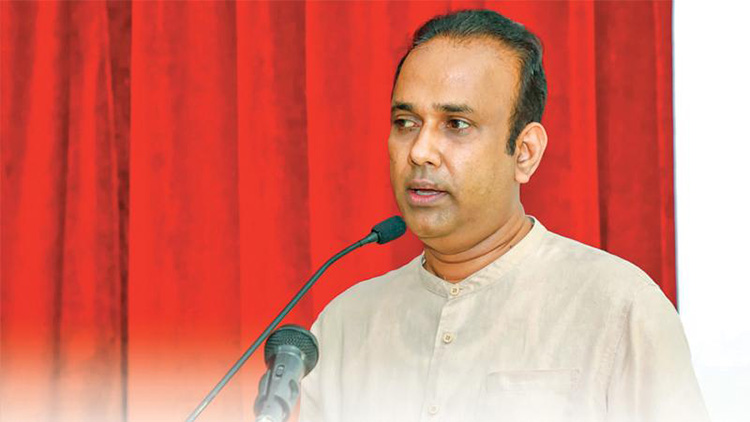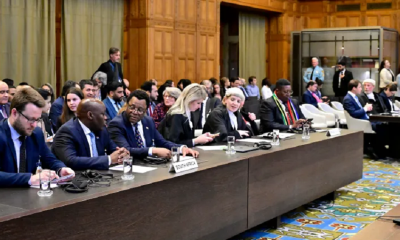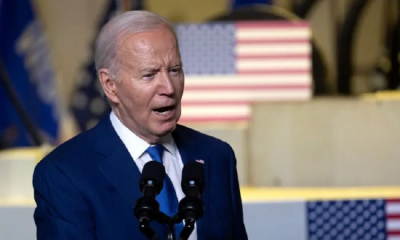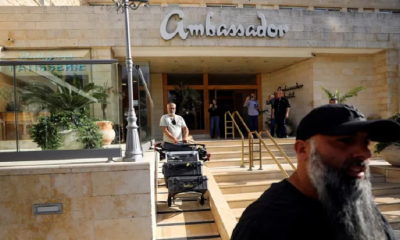Features
Israel’s Gaza Campaign Is the Gravest Moral Crisis of Our Time

The crisis in Gaza shows those nations that should be defending international law and humanitarian values to be openly betraying their commitments.
by Ven. Bhikkhu Bodhi
I write this essay as a senior American Buddhist monk of Jewish ethnicity who has been deeply distressed by Israel’s military assault on the population of Gaza. I see this campaign as perhaps the gravest moral crisis of our time. The blistering bombardments, the ever-mounting death toll, the deadly blockade of vital essentials, the annihilation of innocent human lives—all these events sear the moral consciousness like a red-hot iron and demand a loud shout from the depths of the soul: “For God’s sake, stop it!” Indeed, in its own discreet tones, the International Court of Justice has issued such a shout, yet it seems to have fallen on deaf ears.
Given the many instances of sheer inhumanity unfolding over just two decades—in Iraq, Syria, Tigray, Myanmar, and Ukraine—why should I highlight Gaza as the major moral calamity of our time? I will lay down five reasons why this is the case.
The first concerns the sheer intensity of the assault. Arif Husain, the chief economist at the United Nation’s World Food Program, bears testimony to this with his remark: “I’ve been doing this for the past two decades, and I’ve been to all kinds of conflicts and all kinds of crises. And, for me, this is unprecedented because of, one, the magnitude, the scale, the entire population of a particular place; second, the severity; and third, the speed at which this is happening, at which this has unfolded.”
Unlike the Nazi Holocaust and other war crimes—including Russia’s blood-curdling operations in Ukraine—the genocide in Gaza unfolds live on our television and computer screens, right before our eyes.
The figures representing deaths, injuries, and destruction in Gaza bear out Husain’s words. We are told that 70% of the victims are women and children; that doctors, medical staff, journalists, and university professors are being targeted; that all of Gaza has become a death camp where no one is safe anywhere. We learn of whole families being liquidated at the drop of a bomb, three generations wiped out in an instant; of kids losing their parents and all their siblings, left with no surviving family members in the world; of hospitals being shuttered and their patients forced to walk miles to designated safety zones, only to be hit by sniper fire en route or struck by rockets when they arrive.
On top of the deaths, injuries, and demolitions directly caused by the bombardments, Israel’s near-total blockade of vital essentials—food, water, fuel, and medicines—drives the spike of suffering even more deeply into the hearts of Gaza’s population, subjecting displaced people to extremes of hunger, thirst, and infectious disease. Now that the major Western donors are suspending their funding of UNRWA, the U.N. relief agency for Palestinian refugees, the very lifeline for the people of Gaza is being cut. Like a ravenous hawk, famine hovers just above the strip, ready to strike.
The second factor that underscores the moral gravity of the crisis in Gaza is its visibility, its living immediacy. Unlike the Nazi Holocaust and other war crimes—including Russia’s blood-curdling operations in Ukraine—the genocide in Gaza unfolds live on our television and computer screens, right before our eyes. The images jump out from the screen and beg us to act: children with amputated limbs, their bodies torn and broken; babies abandoned in powerless incubators; apartment buildings and universities collapsing like decks of cards; historic churches and mosques destroyed beyond repair; refugees crammed into infested camps, crying out for water and food; corpses thrown into mass graves; captives blindfolded and stripped naked, paraded like cattle through desolate streets.
Such images make all our normal activities—chatting with friends, going out for a meal, joining a family gathering, going to a concert—seem insipid, hollow, and pointless. Once we bear witness to these horrific crimes, we feel a heavy moral responsibility has fallen on our shoulders, a burden we can’t shake off by claiming these atrocities don’t concern us. The burden is painful, but also exhilarating in reminding us of our capacity for empathy.
A third factor that heightens the moral gravity of the Gaza crisis derives from the fact that it is the state of Israel, the self-declared national home of the Jewish people, that is inflicting all this suffering, anguish, and death on Gaza. Yes, we do hold Israel to a higher moral bar than we do most other nations, but not from anti-Jewish bias. We do so because the Jews are the ethnic group that experienced the horror of the Holocaust and would should therefore be the most vigilant defenders of the inviolable right of people to be free from ethnic persecution.
The vow “Never again,” as understood by Jews of conscience, means never again for anyone. Yet, instead of showing empathy, Israel is now using the past trauma of the Holocaust—and the guilt of the countries that inflicted that trauma—as a shield to silence criticism and maintain its impunity. It’s as if they are saying to the world, “You can’t touch us because you bear the guilt for our past suffering.”
Since we, as Americans, are citizens of the nation foremost in shielding Israel from accountability, this places on us the moral burden of opposing our country’s policies.
The fourth way in which the crisis in Gaza bears moral weight relates specifically to us here in the United States. Our country is complicit in Israel’s crimes. With our own tax dollars, we fund Israel’s military, supplying it with the most advanced weaponry available. We give Israel diplomatic cover at the U.N. through our use of the veto. And we give Israel moral cover by echoing the messages of its propaganda machine at press conferences and international gatherings, while tarring those who criticize its actions.
When all the moral dimensions of the situation in Gaza are viewed together—the sheer volume of indiscriminate killing; the fact that the devastation is starkly visible to us through the media; the fact that the operation is being carried out by the state representing the Jewish people, the historic victims of persecution and genocide; and the complicity of the United States—they point to the fifth reason this is a deeply moral crisis. Taken conjointly, all these factors shatter the moral framework offered to us as the key for understanding our world.
For decades, the major Western powers have presented themselves as the bulwarks of the rules-based international order, the defenders of human rights and decent human morality. Yet now, under the shallowest of pretexts, they throw their weight behind Israel, even when the World Court designates its operations a “plausible genocide.” This unwavering loyalty to a nation that flouts international law overturns the moral lens through which we’ve been taught to view the global order. Now the masks come off, exposing the hypocrisy of the major Western powers hidden behind their polished exteriors.
The crisis in Gaza shows those nations that should be defending international law and humanitarian values to be openly betraying their commitments. Their moral bankruptcy couldn’t be more glaring. They advise Israel to carry out its operations in accordance with international law, but continue to provide it with weapons even when it breaks those laws. They say they favor peace, but at the U.N. Security Council they veto or abstain from resolutions calling for a humanitarian cease-fire. They say they are opposed to genocide, but dispute South Africa’s case at the World Court. They say that Israel should treat prisoners humanely, but turn a blind eye when it tortures, humiliates, and even executes them.
Since we, as Americans, are citizens of the nation foremost in shielding Israel from accountability, this places on us the moral burden of opposing our country’s policies. Given this responsibility, how can we keep silent? There is simply no excuse for standing speechless on the sidelines. We can’t let silence reign as the final word. We can’t let silence replace the word. Since the U.S. government represents us, as Americans we must boldly speak up and oppose its support for Israel’s operations.
The plain fact is that the key to a solution lies in the hands of the U.S. Only if the U.S. applies tough economic and political pressure on Israel can the conflict be justly resolved. And crucially, a just resolution would also serve Israel’s long-term interest, finally permitting it to live at peace with a free Palestinian state, for the mutual benefit of both nations.
Every voice counts, and we can do our share in a variety of ways: by joining marches, writing to the White House and our representatives in Congress, posting relevant news articles and commentary on our social media platforms, writing articles, and talking with friends. It’s not enough to post bromides on social media about love and peace or to pin doves and hearts to our profiles. To fulfill our duty as moral beings, we need to actively express our solidarity with the besieged Palestinians who can’t speak for themselves. And that means, for a starter, calling for a complete cease-fire. Not just for “peace,” but for a real, complete, monitored cease-fire.
But a cease-fire is only the first step. Beyond stopping the present round of destruction, we should also demand a genuine, sincere, concerted attempt to finally fulfill the aspirations of the Palestinian people for a fully sovereign state of their own, which will also be the precious key to Israel’s security. The road to a solution of this long-standing problem will be rocky and hard, but we need to join voices and hands with the many others calling for the first steps to be taken—and to be taken now.
(Ven. Bhikkhu Bodhi is a Buddhist scholar and translator of Buddhist texts. He is also the founder and chair of Buddhist Global Relief, a charity dedicated to helping communities around the world afflicted by chronic hunger and malnutrition.)
Features
The heart-friendly health minister

by Dr Gotabhya Ranasinghe
Senior Consultant Cardiologist
National Hospital Sri Lanka
When we sought a meeting with Hon Dr. Ramesh Pathirana, Minister of Health, he graciously cleared his busy schedule to accommodate us. Renowned for his attentive listening and deep understanding, Minister Pathirana is dedicated to advancing the health sector. His openness and transparency exemplify the qualities of an exemplary politician and minister.
Dr. Palitha Mahipala, the current Health Secretary, demonstrates both commendable enthusiasm and unwavering support. This combination of attributes makes him a highly compatible colleague for the esteemed Minister of Health.
Our discussion centered on a project that has been in the works for the past 30 years, one that no other minister had managed to advance.
Minister Pathirana, however, recognized the project’s significance and its potential to revolutionize care for heart patients.
The project involves the construction of a state-of-the-art facility at the premises of the National Hospital Colombo. The project’s location within the premises of the National Hospital underscores its importance and relevance to the healthcare infrastructure of the nation.
This facility will include a cardiology building and a tertiary care center, equipped with the latest technology to handle and treat all types of heart-related conditions and surgeries.
Securing funding was a major milestone for this initiative. Minister Pathirana successfully obtained approval for a $40 billion loan from the Asian Development Bank. With the funding in place, the foundation stone is scheduled to be laid in September this year, and construction will begin in January 2025.
This project guarantees a consistent and uninterrupted supply of stents and related medications for heart patients. As a result, patients will have timely access to essential medical supplies during their treatment and recovery. By securing these critical resources, the project aims to enhance patient outcomes, minimize treatment delays, and maintain the highest standards of cardiac care.
Upon its fruition, this monumental building will serve as a beacon of hope and healing, symbolizing the unwavering dedication to improving patient outcomes and fostering a healthier society.We anticipate a future marked by significant progress and positive outcomes in Sri Lanka’s cardiovascular treatment landscape within the foreseeable timeframe.
Features
A LOVING TRIBUTE TO JESUIT FR. ALOYSIUS PIERIS ON HIS 90th BIRTHDAY

by Fr. Emmanuel Fernando, OMI
Jesuit Fr. Aloysius Pieris (affectionately called Fr. Aloy) celebrated his 90th birthday on April 9, 2024 and I, as the editor of our Oblate Journal, THE MISSIONARY OBLATE had gone to press by that time. Immediately I decided to publish an article, appreciating the untiring selfless services he continues to offer for inter-Faith dialogue, the renewal of the Catholic Church, his concern for the poor and the suffering Sri Lankan masses and to me, the present writer.
It was in 1988, when I was appointed Director of the Oblate Scholastics at Ampitiya by the then Oblate Provincial Fr. Anselm Silva, that I came to know Fr. Aloy more closely. Knowing well his expertise in matters spiritual, theological, Indological and pastoral, and with the collaborative spirit of my companion-formators, our Oblate Scholastics were sent to Tulana, the Research and Encounter Centre, Kelaniya, of which he is the Founder-Director, for ‘exposure-programmes’ on matters spiritual, biblical, theological and pastoral. Some of these dimensions according to my view and that of my companion-formators, were not available at the National Seminary, Ampitiya.
Ever since that time, our Oblate formators/ accompaniers at the Oblate Scholasticate, Ampitiya , have continued to send our Oblate Scholastics to Tulana Centre for deepening their insights and convictions regarding matters needed to serve the people in today’s context. Fr. Aloy also had tried very enthusiastically with the Oblate team headed by Frs. Oswald Firth and Clement Waidyasekara to begin a Theologate, directed by the Religious Congregations in Sri Lanka, for the contextual formation/ accompaniment of their members. It should very well be a desired goal of the Leaders / Provincials of the Religious Congregations.
Besides being a formator/accompanier at the Oblate Scholasticate, I was entrusted also with the task of editing and publishing our Oblate journal, ‘The Missionary Oblate’. To maintain the quality of the journal I continue to depend on Fr. Aloy for his thought-provoking and stimulating articles on Biblical Spirituality, Biblical Theology and Ecclesiology. I am very grateful to him for his generous assistance. Of late, his writings on renewal of the Church, initiated by Pope St. John XX111 and continued by Pope Francis through the Synodal path, published in our Oblate journal, enable our readers to focus their attention also on the needed renewal in the Catholic Church in Sri Lanka. Fr. Aloy appreciated very much the Synodal path adopted by the Jesuit Pope Francis for the renewal of the Church, rooted very much on prayerful discernment. In my Religious and presbyteral life, Fr.Aloy continues to be my spiritual animator / guide and ongoing formator / acccompanier.
Fr. Aloysius Pieris, BA Hons (Lond), LPh (SHC, India), STL (PFT, Naples), PhD (SLU/VC), ThD (Tilburg), D.Ltt (KU), has been one of the eminent Asian theologians well recognized internationally and one who has lectured and held visiting chairs in many universities both in the West and in the East. Many members of Religious Congregations from Asian countries have benefited from his lectures and guidance in the East Asian Pastoral Institute (EAPI) in Manila, Philippines. He had been a Theologian consulted by the Federation of Asian Bishops’ Conferences for many years. During his professorship at the Gregorian University in Rome, he was called to be a member of a special group of advisers on other religions consulted by Pope Paul VI.
Fr. Aloy is the author of more than 30 books and well over 500 Research Papers. Some of his books and articles have been translated and published in several countries. Among those books, one can find the following: 1) The Genesis of an Asian Theology of Liberation (An Autobiographical Excursus on the Art of Theologising in Asia, 2) An Asian Theology of Liberation, 3) Providential Timeliness of Vatican 11 (a long-overdue halt to a scandalous millennium, 4) Give Vatican 11 a chance, 5) Leadership in the Church, 6) Relishing our faith in working for justice (Themes for study and discussion), 7) A Message meant mainly, not exclusively for Jesuits (Background information necessary for helping Francis renew the Church), 8) Lent in Lanka (Reflections and Resolutions, 9) Love meets wisdom (A Christian Experience of Buddhism, 10) Fire and Water 11) God’s Reign for God’s poor, 12) Our Unhiddden Agenda (How we Jesuits work, pray and form our men). He is also the Editor of two journals, Vagdevi, Journal of Religious Reflection and Dialogue, New Series.
Fr. Aloy has a BA in Pali and Sanskrit from the University of London and a Ph.D in Buddhist Philosophy from the University of Sri Lankan, Vidyodaya Campus. On Nov. 23, 2019, he was awarded the prestigious honorary Doctorate of Literature (D.Litt) by the Chancellor of the University of Kelaniya, the Most Venerable Welamitiyawe Dharmakirthi Sri Kusala Dhamma Thera.
Fr. Aloy continues to be a promoter of Gospel values and virtues. Justice as a constitutive dimension of love and social concern for the downtrodden masses are very much noted in his life and work. He had very much appreciated the commitment of the late Fr. Joseph (Joe) Fernando, the National Director of the Social and Economic Centre (SEDEC) for the poor.
In Sri Lanka, a few religious Congregations – the Good Shepherd Sisters, the Christian Brothers, the Marist Brothers and the Oblates – have invited him to animate their members especially during their Provincial Congresses, Chapters and International Conferences. The mainline Christian Churches also have sought his advice and followed his seminars. I, for one, regret very much, that the Sri Lankan authorities of the Catholic Church –today’s Hierarchy—- have not sought Fr.
Aloy’s expertise for the renewal of the Catholic Church in Sri Lanka and thus have not benefited from the immense store of wisdom and insight that he can offer to our local Church while the Sri Lankan bishops who governed the Catholic church in the immediate aftermath of the Second Vatican Council (Edmund Fernando OMI, Anthony de Saram, Leo Nanayakkara OSB, Frank Marcus Fernando, Paul Perera,) visited him and consulted him on many matters. Among the Tamil Bishops, Bishop Rayappu Joseph was keeping close contact with him and Bishop J. Deogupillai hosted him and his team visiting him after the horrible Black July massacre of Tamils.
Features
A fairy tale, success or debacle

Sri Lanka-Singapore Free Trade Agreement
By Gomi Senadhira
senadhiragomi@gmail.com
“You might tell fairy tales, but the progress of a country cannot be achieved through such narratives. A country cannot be developed by making false promises. The country moved backward because of the electoral promises made by political parties throughout time. We have witnessed that the ultimate result of this is the country becoming bankrupt. Unfortunately, many segments of the population have not come to realize this yet.” – President Ranil Wickremesinghe, 2024 Budget speech
Any Sri Lankan would agree with the above words of President Wickremesinghe on the false promises our politicians and officials make and the fairy tales they narrate which bankrupted this country. So, to understand this, let’s look at one such fairy tale with lots of false promises; Ranil Wickremesinghe’s greatest achievement in the area of international trade and investment promotion during the Yahapalana period, Sri Lanka-Singapore Free Trade Agreement (SLSFTA).
It is appropriate and timely to do it now as Finance Minister Wickremesinghe has just presented to parliament a bill on the National Policy on Economic Transformation which includes the establishment of an Office for International Trade and the Sri Lanka Institute of Economics and International Trade.
Was SLSFTA a “Cleverly negotiated Free Trade Agreement” as stated by the (former) Minister of Development Strategies and International Trade Malik Samarawickrama during the Parliamentary Debate on the SLSFTA in July 2018, or a colossal blunder covered up with lies, false promises, and fairy tales? After SLSFTA was signed there were a number of fairy tales published on this agreement by the Ministry of Development Strategies and International, Institute of Policy Studies, and others.
However, for this article, I would like to limit my comments to the speech by Minister Samarawickrama during the Parliamentary Debate, and the two most important areas in the agreement which were covered up with lies, fairy tales, and false promises, namely: revenue loss for Sri Lanka and Investment from Singapore. On the other important area, “Waste products dumping” I do not want to comment here as I have written extensively on the issue.
1. The revenue loss
During the Parliamentary Debate in July 2018, Minister Samarawickrama stated “…. let me reiterate that this FTA with Singapore has been very cleverly negotiated by us…. The liberalisation programme under this FTA has been carefully designed to have the least impact on domestic industry and revenue collection. We have included all revenue sensitive items in the negative list of items which will not be subject to removal of tariff. Therefore, 97.8% revenue from Customs duty is protected. Our tariff liberalisation will take place over a period of 12-15 years! In fact, the revenue earned through tariffs on goods imported from Singapore last year was Rs. 35 billion.
The revenue loss for over the next 15 years due to the FTA is only Rs. 733 million– which when annualised, on average, is just Rs. 51 million. That is just 0.14% per year! So anyone who claims the Singapore FTA causes revenue loss to the Government cannot do basic arithmetic! Mr. Speaker, in conclusion, I call on my fellow members of this House – don’t mislead the public with baseless criticism that is not grounded in facts. Don’t look at petty politics and use these issues for your own political survival.”
I was surprised to read the minister’s speech because an article published in January 2018 in “The Straits Times“, based on information released by the Singaporean Negotiators stated, “…. With the FTA, tariff savings for Singapore exports are estimated to hit $10 million annually“.
As the annual tariff savings (that is the revenue loss for Sri Lanka) calculated by the Singaporean Negotiators, Singaporean $ 10 million (Sri Lankan rupees 1,200 million in 2018) was way above the rupees’ 733 million revenue loss for 15 years estimated by the Sri Lankan negotiators, it was clear to any observer that one of the parties to the agreement had not done the basic arithmetic!
Six years later, according to a report published by “The Morning” newspaper, speaking at the Committee on Public Finance (COPF) on 7th May 2024, Mr Samarawickrama’s chief trade negotiator K.J. Weerasinghehad had admitted “…. that forecasted revenue loss for the Government of Sri Lanka through the Singapore FTA is Rs. 450 million in 2023 and Rs. 1.3 billion in 2024.”
If these numbers are correct, as tariff liberalisation under the SLSFTA has just started, we will pass Rs 2 billion very soon. Then, the question is how Sri Lanka’s trade negotiators made such a colossal blunder. Didn’t they do their basic arithmetic? If they didn’t know how to do basic arithmetic they should have at least done their basic readings. For example, the headline of the article published in The Straits Times in January 2018 was “Singapore, Sri Lanka sign FTA, annual savings of $10m expected”.
Anyway, as Sri Lanka’s chief negotiator reiterated at the COPF meeting that “…. since 99% of the tariffs in Singapore have zero rates of duty, Sri Lanka has agreed on 80% tariff liberalisation over a period of 15 years while expecting Singapore investments to address the imbalance in trade,” let’s turn towards investment.
Investment from Singapore
In July 2018, speaking during the Parliamentary Debate on the FTA this is what Minister Malik Samarawickrama stated on investment from Singapore, “Already, thanks to this FTA, in just the past two-and-a-half months since the agreement came into effect we have received a proposal from Singapore for investment amounting to $ 14.8 billion in an oil refinery for export of petroleum products. In addition, we have proposals for a steel manufacturing plant for exports ($ 1 billion investment), flour milling plant ($ 50 million), sugar refinery ($ 200 million). This adds up to more than $ 16.05 billion in the pipeline on these projects alone.
And all of these projects will create thousands of more jobs for our people. In principle approval has already been granted by the BOI and the investors are awaiting the release of land the environmental approvals to commence the project.
I request the Opposition and those with vested interests to change their narrow-minded thinking and join us to develop our country. We must always look at what is best for the whole community, not just the few who may oppose. We owe it to our people to courageously take decisions that will change their lives for the better.”
According to the media report I quoted earlier, speaking at the Committee on Public Finance (COPF) Chief Negotiator Weerasinghe has admitted that Sri Lanka was not happy with overall Singapore investments that have come in the past few years in return for the trade liberalisation under the Singapore-Sri Lanka Free Trade Agreement. He has added that between 2021 and 2023 the total investment from Singapore had been around $162 million!
What happened to those projects worth $16 billion negotiated, thanks to the SLSFTA, in just the two-and-a-half months after the agreement came into effect and approved by the BOI? I do not know about the steel manufacturing plant for exports ($ 1 billion investment), flour milling plant ($ 50 million) and sugar refinery ($ 200 million).
However, story of the multibillion-dollar investment in the Petroleum Refinery unfolded in a manner that would qualify it as the best fairy tale with false promises presented by our politicians and the officials, prior to 2019 elections.
Though many Sri Lankans got to know, through the media which repeatedly highlighted a plethora of issues surrounding the project and the questionable credentials of the Singaporean investor, the construction work on the Mirrijiwela Oil Refinery along with the cement factory began on the24th of March 2019 with a bang and Minister Ranil Wickremesinghe and his ministers along with the foreign and local dignitaries laid the foundation stones.
That was few months before the 2019 Presidential elections. Inaugurating the construction work Prime Minister Ranil Wickremesinghe said the projects will create thousands of job opportunities in the area and surrounding districts.
The oil refinery, which was to be built over 200 acres of land, with the capacity to refine 200,000 barrels of crude oil per day, was to generate US$7 billion of exports and create 1,500 direct and 3,000 indirect jobs. The construction of the refinery was to be completed in 44 months. Four years later, in August 2023 the Cabinet of Ministers approved the proposal presented by President Ranil Wickremesinghe to cancel the agreement with the investors of the refinery as the project has not been implemented! Can they explain to the country how much money was wasted to produce that fairy tale?
It is obvious that the President, ministers, and officials had made huge blunders and had deliberately misled the public and the parliament on the revenue loss and potential investment from SLSFTA with fairy tales and false promises.
As the president himself said, a country cannot be developed by making false promises or with fairy tales and these false promises and fairy tales had bankrupted the country. “Unfortunately, many segments of the population have not come to realize this yet”.
(The writer, a specialist and an activist on trade and development issues . )
























